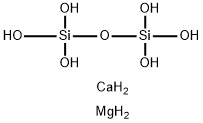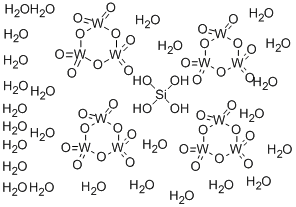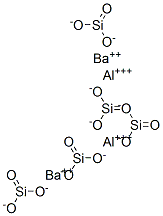Silicic acid
- CAS NO.:7699-41-4
- Empirical Formula: H2O3Si
- Molecular Weight: 78.1
- MDL number: MFCD00054122
- EINECS: 231-716-3
- SAFETY DATA SHEET (SDS)
- Update Date: 2025-01-27 09:38:02

What is Silicic acid?
Description
Silicic acid is the general name that refers to the group of chemical compounds of the element hydrogen, silicon, and oxygen with the formula [SiOx(OH)4-2x]n. H4SiO4 is the most predominant form. Silicic acid is a hydrated form of silicon dioxide. It belongs to the family of Miscellaneous Silicates. These are inorganic compounds in which the largest metallic oxoanion is silicate, to which either no atom or a non metal atom is bonded. Silicic acid is contained in many foods, such as grain, fruit and vegetables (borage). It is commonly used in the manufacture of toothpastes and as a stationary phase for chromatography.It is utilized for the manufacture catalyst and catalyst carrier. It is involved in tungsten filament production as chemical reagent and flux. Further, it is used for oil and wax decoloring.
Chemical properties
Amorphous silica, the noncrystalline form of SiO2, is a transparent to gray, odorless, amorphous powder
The Uses of Silicic acid
Silicic acid is used in protein chromatography. Silicic acid has been used in a study to demonstrate the anti-biofilm potential of a glycolipid surfactant produced by a tropical marine strain of Serratia marcescens. Silicic acid has also been used to study the antioxidant activity of fresh and processed Jalapen?o and Serrano peppers.
The Uses of Silicic acid
Laboratory reagent and reinforcing agent in rubber.
Definition
The jellylike precipitate obtained when sodium silicate solution is acidified. The proportion of water varies with the conditions of preparation and decreases gradually during drying and ignition, until relatively pure silica remains. During drying the je
Biochem/physiol Actions
Silicic acid polymers are employed in water treatment systems, drug encapsulation cum delivery and for soluble nanoparticle generation. Silicic acid interacts with aluminum and reduces its bioavailability. It is an effective antidote for aluminum poisoning.
Safety Profile
An inhalation hazard. Poison by intravenous route. An eye irritant and nuisance dust. Questionable carcinogen. Mutation data reported. See also other silica entries and SILICATES
Potential Exposure
Amorphous fumed silica is used as a mineral, natural or synthetic fiber. A potential danger to those involved in the production and handling of fumed silica for paint pigments or catalysts. Diatomaceous earth is used in clarifying liquids, in manufacture of fire brick and heat insulators; used as a filtering agent; as a filler in construction materials; pesticides, paints, and varnishes. A potential danger to those involved in mining of diatomaceous earth or fabrication of products there from.
Incompatibilities
Silica, amorphous is a noncombustible solid. Generally unreactive chemically. Incompatible with fluorine, oxygen difluoride, chlorine trifluoride. Soluble in molten alkalis and reacts with most metallic oxides at high temperature.
Waste Disposal
Sanitary landfill.
Properties of Silicic acid
| Melting point: | 1704℃ |
| solubility | insoluble in H2O; soluble in HF |
| form | powder |
| color | White |
| Dielectric constant | 2.0(Ambient) |
| CAS DataBase Reference | 7699-41-4(CAS DataBase Reference) |
| EPA Substance Registry System | Silicic acid (H2SiO3) (7699-41-4) |
Safety information for Silicic acid
| Signal word | Warning |
| Pictogram(s) |
 Exclamation Mark Irritant GHS07 |
| GHS Hazard Statements |
H319:Serious eye damage/eye irritation H335:Specific target organ toxicity, single exposure;Respiratory tract irritation |
| Precautionary Statement Codes |
P261:Avoid breathing dust/fume/gas/mist/vapours/spray. P264:Wash hands thoroughly after handling. P264:Wash skin thouroughly after handling. P271:Use only outdoors or in a well-ventilated area. P280:Wear protective gloves/protective clothing/eye protection/face protection. P305+P351+P338:IF IN EYES: Rinse cautiously with water for several minutes. Remove contact lenses, if present and easy to do. Continuerinsing. |
Computed Descriptors for Silicic acid
New Products
Indole Methyl Resin tert-butyl 9-methoxy-3-azaspiro[5.5]undecane-3-carboxylate Boc-His(Boc)-OH 2-CTC Resin 4-Chloro-7-tosy1-7Hpyrrolo[2,3-d]pyrimidine 5,7-Dibromo-1H-indole 2,5-dichloro-N-hydroxy-4,6-dimethylpyridine-3-carboximidamide 2,2-Dimethoxy-7-azaspiro[3.5]nonane hydrochloride 4-chloromethyl-5-methyl-1,3-dioxol-2-one (DMDO-Cl) R-2-BENZYLOXY PROPIONIC ACID 1,1’-CARBONYLDIIMIDAZOLE 1,1’-CARBONYLDI (1,2-4 TRIAZOLE) N-METHYL INDAZOLE-3-CARBOXYLIC ACID 4-((2-hydroxyethyl)thio)benzoic acid 1-(TERT-BUTOXYCARBONYL)-2-PYRROLIDINONE Methyl 6-methylnicotinate 3-Pyridineacrylic acid tert-Butyl carbazate TETRAHYDRO-2H-PYRAN-3-OL 2-((4-morpholinophenylamino) (methylthio) methylene) malononitrile 3-(4-morpholinophenylamino)-5-amino-1H-pyrazole-4-carbonitrile 2,4-dihydroxybenzaldehyde 1,3-Diethyl-1,3-Diphenylurea Methyl 2-methylquinoline-6-carboxylateRelated products of tetrahydrofuran








You may like
-
 Precipitated Silica 98%View Details
Precipitated Silica 98%View Details -
 Precipitated Silica 99%View Details
Precipitated Silica 99%View Details -
 Silicic acid CAS 7699-41-4View Details
Silicic acid CAS 7699-41-4View Details
7699-41-4 -
 Silicic acid CAS 7699-41-4View Details
Silicic acid CAS 7699-41-4View Details
7699-41-4 -
 Silicic acid CAS 7699-41-4View Details
Silicic acid CAS 7699-41-4View Details
7699-41-4 -
 Pyridine 99.5% HPLC /UV SpectroscopyView Details
Pyridine 99.5% HPLC /UV SpectroscopyView Details
110-86-1 -
 Dibutyl PhthalateView Details
Dibutyl PhthalateView Details
84-74-2 -
 Thiourea 99% ARView Details
Thiourea 99% ARView Details
62-56-6
